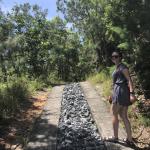Support
I had the opportunity to study abroad in Cairns, Australia for the start of the spring 2020 semester. While there, I had hoped to explore a number of the incredible national parks throughout the continent. While corona cut the semester short and kept me closer to home, I still was fortunate enough to visit several national parks in Tropical North Queensland. My hope with this project was to explore sustainability infrastructures put in place to preserve the diverse natural landscape. I was inspired to do this project after spending my sophomore fall on the St. Lawrence Adirondack semester. During those four months spent in the heart of the Adirondacks, we learned a great deal about the history of the park and the regulations put in place to protect it. As an outdoor studies minor, I am curious about both the preservation of the outdoors, and the access to it. I wanted to take this experience and broaden it to natural areas on the other side of the world; with different laws, people, landscapes, ecosystems, and organisms.
Through the generosity of the Giltz family, I was able to explore Wooroonooran National Park on three different occasions, Kuranda National Park, Barron Gorge National Park, and Fitzroy Island National Park. Among these excursions, I was able to experience many different levels of infrastructure and accessibility.
The various parks offered adventures for people of all experiences and abilities, and I was able to visit tourist hotspots as well as hidden local treasures. Kuranda and Barron Gorge offer a tourist hotspot, with ways to traverse these areas such as train, car, by foot, and most famously, by sky-rail. The high infrastructure of the park remained successful in sustaining the essence of the natural landscape. Boardwalks high up in the rainforest lead down to meet up with the train tracks at a lookout with a beautiful and accessible view of the Gorge.
Wooroonooran National Park offers outdoor excursions with varying degrees of infrastructure. Josephine falls is a short walk from the parking lot, with well maintained walkways, pristine water, with platforms and railings overlooking the water. While there, a tour bus of about 30 came through making the water quite busy, but proving that the falls offered outdoor activities suited to everyone. Our next trip was to Nandroya Falls, which was nestled deep into the heart of the park, with a longer, muddy, leech filled, and beautiful walk through the woods. We were only joined by two other people at the falls that day, adding to the allure of the spot but also speaking to the limited access of it. My final trip to Wooroonooran brought me to Pete’s falls. Easily the least accessible and hardly maintained, the trail to the falls was a bit grueling but well worth the effort.
On our second to last day in Australia, we took a ferry out to Fitzroy Island National Park. The small island is a huge tourist hot spot, with an eco resort right in the center. The National Park side of the island has a quite steep hike up to the summit which looks out over the park. While steep, the majority of the route was paved. The resort did not allow access to non-guests, but follow-up research found that the resort has removed and replaced all single use plastics, treats and monitors waste on site, and sponsors many reef restoration and health projects. The resort also funds a turtle rehabilitation center on the island.
I am so grateful to the Giltz family for their generosity that opened many opportunities that made my abridged time abroad so impactful. I hope to go back to Australia (in a post-pandemic time) and continue the travel I was able to begin this past spring. Additionally, post-grad I hope to work in outdoor education or conservation work at some point, such as AmeriCorps, in which I can apply this knowledge.
